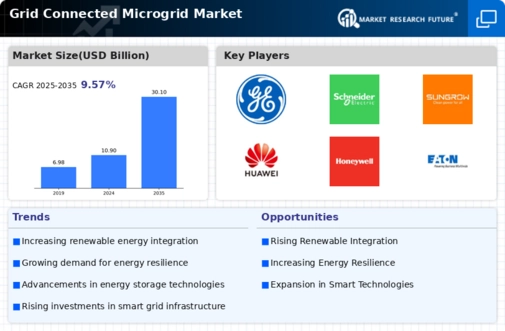Market Growth Projections
The Global Grid Connected Microgrid Market Industry is poised for substantial growth in the coming years. Projections indicate a market value of 10.9 USD Billion in 2024, with expectations to reach 30.1 USD Billion by 2035. This growth reflects a compound annual growth rate of 9.64% from 2025 to 2035, driven by various factors including technological advancements, government policies, and increasing energy demands. The market's expansion is indicative of a broader transition towards decentralized energy systems, highlighting the importance of microgrids in the global energy landscape.
Government Incentives and Policies
Government incentives and policies significantly influence the Global Grid Connected Microgrid Market Industry. Many governments are offering financial incentives, tax credits, and grants to promote the development of microgrids. For example, the U.S. Department of Energy has initiated various programs to support microgrid projects, recognizing their potential to enhance energy security and resilience. Such initiatives not only lower the financial barriers for developers but also stimulate investment in microgrid technologies. As these policies continue to evolve, they are likely to create a favorable environment for market growth, further solidifying the role of microgrids in the global energy landscape.
Rising Demand for Renewable Energy
The Global Grid Connected Microgrid Market Industry experiences a surge in demand for renewable energy sources, driven by the global shift towards sustainability. Governments worldwide are implementing policies to reduce carbon emissions, which encourages the adoption of microgrids that integrate solar, wind, and other renewable resources. For instance, countries like Germany and the United States are investing heavily in microgrid projects to enhance energy resilience and sustainability. This trend is expected to contribute to the market's growth, with projections indicating a market value of 10.9 USD Billion in 2024 and a significant increase to 30.1 USD Billion by 2035.
Resilience Against Natural Disasters
The Global Grid Connected Microgrid Market Industry is increasingly recognized for its potential to enhance resilience against natural disasters. Microgrids can operate independently from the main grid during emergencies, providing critical power to essential services such as hospitals and emergency response centers. This capability is particularly vital in regions prone to extreme weather events. As climate change intensifies, the demand for resilient energy systems is likely to grow. Governments and organizations are investing in microgrid technologies to ensure energy security during crises, thereby contributing to the market's growth trajectory.
Increasing Urbanization and Energy Demand
The Global Grid Connected Microgrid Market Industry is significantly impacted by increasing urbanization and the corresponding rise in energy demand. Rapid urban growth leads to higher energy consumption, necessitating the development of efficient energy solutions. Microgrids offer localized energy generation and distribution, which can alleviate pressure on traditional grid systems. Cities around the world are exploring microgrid implementations to enhance energy reliability and reduce transmission losses. This trend is expected to drive market expansion, as urban areas seek innovative solutions to meet their energy needs sustainably and efficiently.
Technological Advancements in Energy Storage
Technological advancements in energy storage systems play a crucial role in the Global Grid Connected Microgrid Market Industry. Innovations in battery technology, such as lithium-ion and flow batteries, enhance the efficiency and reliability of microgrids. These advancements enable better integration of renewable energy sources, allowing for energy storage during peak production times and utilization during demand spikes. As energy storage becomes more affordable and efficient, the adoption of microgrids is likely to increase. This shift is anticipated to drive the market at a compound annual growth rate of 9.64% from 2025 to 2035, reflecting a growing reliance on advanced energy solutions.















